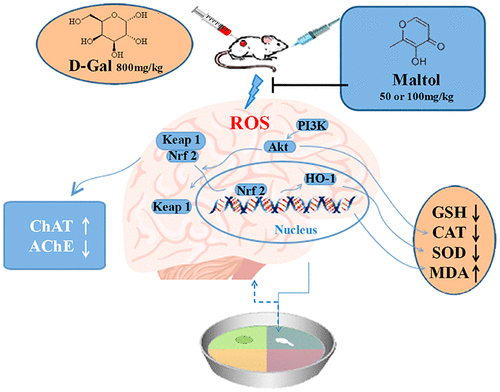当前位置:
X-MOL 学术
›
J. Agric. Food Chem.
›
论文详情
Our official English website, www.x-mol.net, welcomes your
feedback! (Note: you will need to create a separate account there.)
Maltol (3-Hydroxy-2-methyl-4-pyrone) Slows d-Galactose-Induced Brain Aging Process by Damping the Nrf2/HO-1-Mediated Oxidative Stress in Mice
Journal of Agricultural and Food Chemistry ( IF 5.7 ) Pub Date : 2019-08-28 00:00:00 , DOI: 10.1021/acs.jafc.9b04614 Ji-yue Sha 1 , Yan-dan Zhou 1 , Jia-yu Yang 1 , Jing Leng 1 , Jian-hao Li 1 , Jun-nan Hu 1 , Wei Liu 1 , Shuang Jiang 1 , Ying-ping Wang 1, 2 , Chen Chen 3 , Wei Li 1, 2
Journal of Agricultural and Food Chemistry ( IF 5.7 ) Pub Date : 2019-08-28 00:00:00 , DOI: 10.1021/acs.jafc.9b04614 Ji-yue Sha 1 , Yan-dan Zhou 1 , Jia-yu Yang 1 , Jing Leng 1 , Jian-hao Li 1 , Jun-nan Hu 1 , Wei Liu 1 , Shuang Jiang 1 , Ying-ping Wang 1, 2 , Chen Chen 3 , Wei Li 1, 2
Affiliation

|
Maltol, a maillard reaction product from ginseng (Panax ginseng C. A. Meyer), has been confirmed to inhibit oxidative stress in several animal models. Its beneficial effect on oxidative stress related brain aging is still unclear. In this study, the mouse model of d-galactose (d-Gal)-induced brain aging was employed to investigate the therapeutic effects and potential mechanisms of maltol. Maltol treatment significantly restored memory impairment in mice as determined by the Morris water maze tests. Long-term d-Gal treatment reduced expression of cholinergic regulators, i.e., the cholineacetyltransferase (ChAT) (0.456 ± 0.10 vs 0.211 ± 0.03 U/mg prot), the acetylcholinesterase (AChE) (36.4 ± 5.21 vs 66.5 ± 9.96 U/g). Maltol treatment prevented the reduction of ChAT and AChE in the hippocampus. Maltol decreased oxidative stress levels by reducing levels of reactive oxygen species (ROS) and malondialdehyde (MDA) production in the brain and by elevating antioxidative enzymes. Furthermore, maltol treatment minimized oxidative stress by increasing the phosphorylation levels of phosphatidylinositol-3-kinase (PI3K), protein kinase B (Akt), nuclear factor-erythroid 2-related factor 2 (Nrf2), and hemeoxygenase-1 (HO-1). The above results clearly indicate that supplementation of maltol diminishes d-Gal-induced behavioral dysfunction and neurological deficits via activation of the PI3K/Akt-mediated Nrf2/HO-1 signaling pathway in brain. Maltol might become a potential drug to slow the brain aging process and stimulate endogenous antioxidant defense capacity. This study provides the novel evidence that maltol may slow age-associated brain aging.
中文翻译:

麦芽酚(3-羟基-2-甲基-4-吡喃酮)通过抑制小鼠Nrf2 / HO-1-介导的氧化应激来减慢d-半乳糖诱导的大脑衰老过程。
麦芽酚是人参(人参CA Meyer)的美拉德反应产物,已在多种动物模型中抑制氧化应激。它对与氧化应激相关的脑衰老的有益作用仍不清楚。在这项研究中,d-半乳糖(d- Gal)诱导的脑衰老小鼠模型用于研究麦芽酚的治疗效果和潜在机制。如莫里斯水迷宫测试所确定,麦芽酚处理可显着恢复小鼠的记忆障碍。长期d-Gal处理可降低胆碱能调节剂的表达,即胆碱乙酰基转移酶(ChAT)(0.456±0.10 vs 0.211±0.03 U / mg脯氨酸),乙酰胆碱酯酶(AChE)(36.4±5.21 vs 66.5±9.96 U / g)。麦芽酚治疗防止了海马中ChAT和AChE的降低。麦芽酚通过降低大脑中的活性氧(ROS)和丙二醛(MDA)的产生水平,以及通过增加抗氧化酶来降低氧化应激水平。此外,麦芽酚处理可通过增加磷脂酰肌醇-3-激酶(PI3K),蛋白激酶B(Akt),核因子-类胡萝卜素2相关因子2(Nrf2)和血红素加氧酶-1(HO-1)的磷酸化水平来最大程度地降低氧化应激。 )。上述结果清楚地表明的麦芽酚减小,补充d-Gal通过激活脑中PI3K / Akt介导的Nrf2 / HO-1信号传导途径诱导的行为障碍和神经功能缺损。麦芽酚可能成为减缓大脑衰老过程并刺激内源性抗氧化剂防御能力的潜在药物。这项研究提供了新的证据,证明麦芽酚可以减缓与年龄有关的大脑衰老。
更新日期:2019-08-28
中文翻译:

麦芽酚(3-羟基-2-甲基-4-吡喃酮)通过抑制小鼠Nrf2 / HO-1-介导的氧化应激来减慢d-半乳糖诱导的大脑衰老过程。
麦芽酚是人参(人参CA Meyer)的美拉德反应产物,已在多种动物模型中抑制氧化应激。它对与氧化应激相关的脑衰老的有益作用仍不清楚。在这项研究中,d-半乳糖(d- Gal)诱导的脑衰老小鼠模型用于研究麦芽酚的治疗效果和潜在机制。如莫里斯水迷宫测试所确定,麦芽酚处理可显着恢复小鼠的记忆障碍。长期d-Gal处理可降低胆碱能调节剂的表达,即胆碱乙酰基转移酶(ChAT)(0.456±0.10 vs 0.211±0.03 U / mg脯氨酸),乙酰胆碱酯酶(AChE)(36.4±5.21 vs 66.5±9.96 U / g)。麦芽酚治疗防止了海马中ChAT和AChE的降低。麦芽酚通过降低大脑中的活性氧(ROS)和丙二醛(MDA)的产生水平,以及通过增加抗氧化酶来降低氧化应激水平。此外,麦芽酚处理可通过增加磷脂酰肌醇-3-激酶(PI3K),蛋白激酶B(Akt),核因子-类胡萝卜素2相关因子2(Nrf2)和血红素加氧酶-1(HO-1)的磷酸化水平来最大程度地降低氧化应激。 )。上述结果清楚地表明的麦芽酚减小,补充d-Gal通过激活脑中PI3K / Akt介导的Nrf2 / HO-1信号传导途径诱导的行为障碍和神经功能缺损。麦芽酚可能成为减缓大脑衰老过程并刺激内源性抗氧化剂防御能力的潜在药物。这项研究提供了新的证据,证明麦芽酚可以减缓与年龄有关的大脑衰老。


















































 京公网安备 11010802027423号
京公网安备 11010802027423号